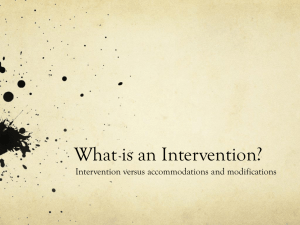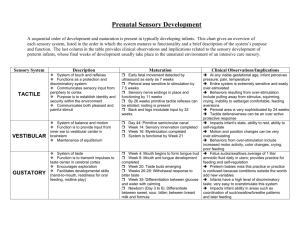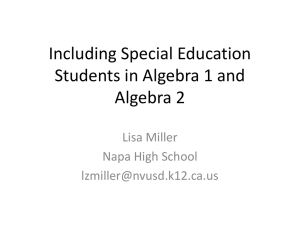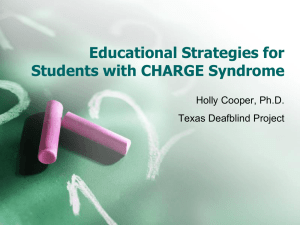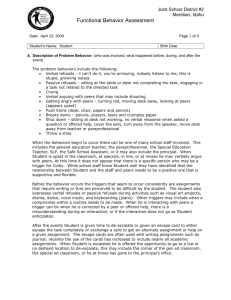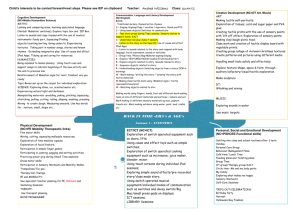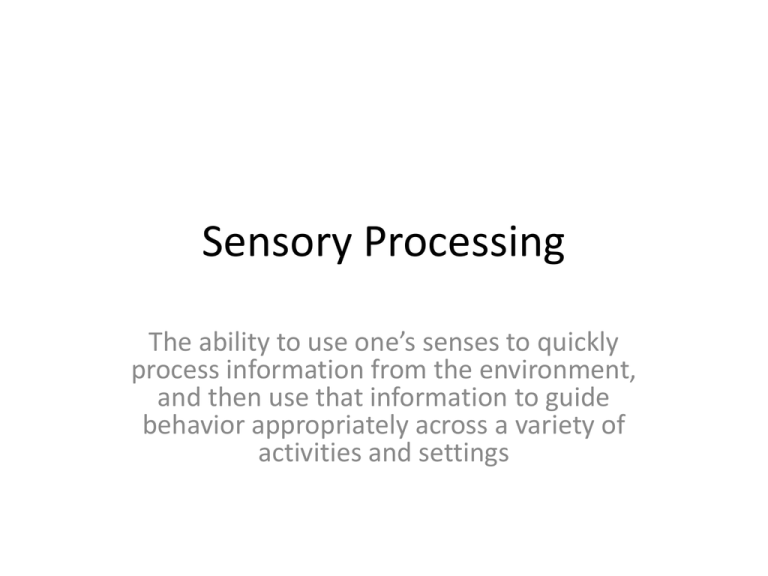
Sensory Processing
The ability to use one’s senses to quickly
process information from the environment,
and then use that information to guide
behavior appropriately across a variety of
activities and settings
The Five Basic Senses
• Sight- Visual processing including under-and over-responsiveness,
excessive seeking of visual input, and problems with perception
• Hearing– Auditory processing, over- and under-responsiveness,
seeking behavior, and perceptual difficulties
• Touch– Tactile processing including tactile defensiveness, or overresponsiveness to touch sensations, and under-responsiveness with
and without tactile seeking behaviors
• Smell– Olfactory processing including over- and underresponsiveness, avoidance and seeking behaviors
• Taste- Over- or under-responsiveness to tastes, avoidance and
seeking behaviors. This area is closely ties to olfactory processing.
Not to be confused with oral-tactile processing deficits.
The Complex Senses
•
•
•
Vestibular- This is our movement sense. It includes our ability to sense and use the force of
gravity for movement. Balance is an important function of this system. The vestibular sense
allows us to move smoothly and balance while engaged in activities. Under- or overresponsiveness in this system will impact a person’s ability to maintain sitting posture, as well
as to execute and control coordinated body movements such as running, jumping, or riding a
bike. Children may crave excessive movement or avoid movement, especially when feet are
not on the ground.
Proprioceptive- This is our body position sense. Proprioception is the ability to know where a
body part is without having to look. It also helps us determine how much force is required to
complete an action successfully. It is an essential component of coordinated movements,
such as grasping a utensil or catching a ball. Under- or over-responsiveness in this system will
impact a person’s ability to navigate around obstacles, use appropriate force when using
tools, and perform precision fine motor tasks efficiently.
Praxis- This is not itself a sensory system, it is a higher level cognitive function that depends
on the integration of multiple sensory systems, particularly tactile perception and
proprioception, in order to function efficiently. Praxis is the ability to conceptualize, plan and
organize movements in order to complete an unfamiliar motor tasks and then adapt our
movements to improve success in the future.
Some Possible Signs of Sensory
Processing and Integration Issues
•
•
•
•
•
•
•
•
•
•
•
•
•
Delays in speech, motor skills or academic achievement
Overly sensitive or under-reactive to touch, movement, sights or sounds in the
environment
Unusually high or low activity level
Easily distracted; poor attention to tasks (attending to TV doesn’t count!)
Coordination problems; appears awkward or clumsy
Decreased awareness of body in space or spatial relationships between body and
items in environment
Difficulty using both hands together to perform simple tasks
Difficult with transitions between activities, environments, or states of arousal
Resistance to changes in routine
Difficulty learning new tasks or playing appropriately with unfamiliar toys
Inability to come up with new ideas for play
Immature social skills
Impulsivity or difficulty with self-control
Executive Function
• From Executive Skills in Children and Adolescents, by
Peg Dawson and Richard Guare
• Executive function is a neuropsychological concept
referring to the high level cognitive processes required
to plan and direct activities, including task initiation
and follow-throuhg, working memory, sustained
attention, performance monitoring, inhibition of
impulses, and goal-directed persistence.
• Executive skills are mainly located in the prefrontal
cortex of the brain. These areas are the last to fully
develop in late adolescence.
The executive functions operate like the conductor of an
orchestra who selects the pieces of music to be played
and then organizes the musicians – starting them,
integrating, and stopping their playing, keeping them in
time, and fading various players in and out as needed to
play their respective parts. If the orchestra is not working
with the conductor, each musician is just as talented as
they were WITH the conductor, but the music the
orchestra can make together will not be as well timed,
balanced, or crisp as with the conductor. This is part of
what leads to the misinterpretation that a person with
executive skills deficits is willfully not achieving or
meeting expectations. (Laura Ehlert, Psy.D.)
• A child cannot have ADHD and not have deficits in
executive function.
• A child can have executive function deficits and NOT have
ADHD.
• Executive function can be situational…difficulties can be
intermittent.
• Don’t assume a child WON’T complete the task just
because they didn’t yesterday. It may actually be that they
CAN’T get it done today.
• Fair does not mean equal! At home or at school, each child
has differing needs to be successful. Helping teachers,
parents, siblings and others to understand that
accommodations are only “leveling the playing field” is
important. You would not expect a paraplegic to walk up
the stairs. You would expect them to take the elevator.
Developmental Tasks requiring
Executive Skills:
Preschoolers:
• Follow Simple Directions- go get your jacket
• Pick up Toys
• Brush teeth, clear dishes
• Inhibit some behaviors such as not touching the hot stove, running into the street, don’t hit, begin
to share things
Kindergarten to grade 2:
• 2-3 step directions- get shoes, jacket and backpack
• Pick up their bedroom and make bed- with reminders/support
• Be responsible to bring papers to and from school
• Inhibit behaviors such as following general safety rules, poor language, raise hand at school before
speaking, keeping hands to self
Grades 3-5
• Can do time delayed errands: go to neighbor’s to pick up something, remember to do something
after school
• Vacuuming or dusting, clean up the kitchen (more complex)
• Remember assignments and materials for homework
• Complete homework independently, plan and complete a project (book report)
• Keep track of daily schedule and changes
• Save money/delay gratification for a long-term goal
• Inhibit/self-regulate: behave even when no adult watching, no temper tantrums
Developmental Tasks requiring
Executive Skills: Continued
Grade 6-8
• Help out with many chores/tasks at home
• Baby-sit young siblings
• Has system for organizing school work
• Can follow complex school schedule involving multiple classes/teachers
• Plan/carry out long-term projects with timeline, perhaps multiple projects at once
• Plan time including after/during/before school, homework, family responsibilities
• Inhibit rule breaking in the absence of visible authority
High School:
• Manage schoolwork on a daily basis, handing in and corrdinating time for
completion by due dates for multiple teachers/activities
• Make and keep long-term goals with realistic plans for meeting these goals
• See the connection to high school and the long-term goal of college, what needs
to be done in order to make that happen
• Make positive use of leisure time, employment, sports, activities, etc.
• Inhibit reckless and dangerous behaviors: drugs, sex, vandalism, etc
Ten principles for Improving Your
Child’s Executive Skills
• Teach deficient skills rather than expecting the child to acquire them
through observation or osmosis
• Consider your child’s developmental level
• Move from the external to the internal
• Remember that the external includes changes you can make in the
environment, the task, or the way you interact with your child.
• Use rather than fight the child’s innate drive for mastery and control.
• Modify tasks to match your child’s capacity to exert effort
• Use incentives to augment instruction
• Provide just enough support for the child to be successful
• Keep supports and supervision in place until the child achieves mastery or
success
• When you do stop the supports, supervision and incentives, fade them
gradually, never abruptly.
Simple Accommodations and
Modifications in the Classroom:
• Accommodations are changes in how a student
accesses information
• The changes are made in order to provide a
student with equal access to learning and an
equal opportunity to show what he or she knows
and can do. It levels the playing field
• Modifications are changes in what a student is
expected to learn
• The changes allow for the opportunity to
participate meaningfully and productively along
with other students in the classroom
Environmental Accommodations
• Sensory breaks- drink, walk, send student on
errand
• Seat student away from distractions, quiet area
• Behavior cue cards
• Sensory stimulation- stress balls, fidget toys, etc.
• Headphones
• Lights
• Carpet
Content Instruction Accommodations
• Give basic introduction to the subject immediately
before starting the lesson for the whole class – elicit
prior knowledge
• Include hands-on experiences and manipulatives
whenever possible
• Rephrase the questions to check for understanding
• Response time… ask the question and come back
• Mnemonic devices
• Partner students with strategically-capable peers
• Graphic organizers
• Study guides, notes, well in advance, page numbers
Assignment Accommodations
• Highlighting with colored highlighters, tape, using
post-its
• Compare notes to teacher’s or classmate’s
• Color coding
• Extended Time
• Assignments can be turned in late
• Reduced homework assignments
• No penalty for spelling errors
• Re-do’s, NO missing assignments or zeros
Assignment Accommodations
• Keep questions in the order of reading
material
• Provide word bank
• Break materials into smaller parts
• Take turns- you do a problem, the student
does a problem
• Visual organizers
Modifications
•
•
•
•
Changes in instructional level
Changes in content/curriculum
Changes in performance criteria
Changes in assignment structure- paper/pencil
work
Content Instruction Modifications
• Reduce the variety of tasks- less tasks on one sheet of
paper. Give one sheet at a time
• Make it meaningful… what do they need to know? Highlight
the information…when lecturing…write this down…this is
important…what is key
• Eliminate less critical information
• Find ways to involve students in class
• Teach a system to prepare a student to answer a question
• Books on tape, videos
• Visual organizers
• Differentiate instruction



